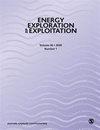巴西煤炭、泥炭和生物质的真空热解--原料、固体残留物、热解液和转化率的表征结果
IF 1.6
4区 工程技术
Q4 ENERGY & FUELS
引用次数: 0
摘要
煤炭、泥炭和生物质等固体燃料的热解可将其转化为固体和液体产品,副产品为不凝性气体。本研究利用真空热解技术评估了巴西煤炭、泥炭和生物质样本的转化特性。通过近似和最终分析、总热值、岩相分析、对二氧化碳的反应性、拉曼光谱和有机地球化学方法(萃取、液相色谱法),对在真空热解条件下获得的原料及其各自的固体残渣(焦炭)和热解液进行了表征。原料样品和固体残留物的化学和物理特性变化很大。煤炭的平均玻璃光泽反射率从 0.44% 到 1.18% Rrandom 不等,表明其等级范围从亚烟煤到高挥发性/中等挥发性烟煤。从煤炭、泥炭和生物质固体残留物中鉴定出的玻璃微粒的反射率测量值从 2.10% 到 10.64% Rrandom 不等。对液体产物的分析表明,在热解过程中,大多数样品中的脂肪族部分有增加的趋势,而且在可冷凝液体中主要形成极性化合物。研究结果表明,在调查的煤炭样本中,圣卡塔琳娜州的高挥发性烟煤主要转化为液体和气体(29.7%-33.2%),而生物质样本马莫纳(蓖麻)、木屑(桉树)、木条(松树)和信号草的转化率均为 60%。泥炭样本的转化率介于 32.5% 和 46.6% 之间。在玻璃质生物质炭上测定的反射率值表明,它可以用于土壤改良。本文章由计算机程序翻译,如有差异,请以英文原文为准。
Vacuum Pyrolysis of Brazilian coal, peat and biomass – Results on characterization of feedstock, solid residues, pyrolysis liquids and conversion rates
Pyrolysis of solid fuels such as coal, peat and biomass enables conversion into solid and liquid products, with noncondensable gas being a by-product. The present study evaluates conversion characteristics of Brazilian coal, peat and biomass samples using vacuum pyrolysis techniques. Feedstock and their respective solid residues (chars) and pyrolytic liquids obtained under vacuum pyrolysis conditions were characterized by proximate and ultimate analyses, gross calorific value, petrographic analyses, reactivity to CO2 , Raman spectroscopy and organic geochemical methods (extraction, liquid chromatography). Chemical and physical properties in the feedstock samples and solid residues are highly variable. In the coals mean vitrinite reflectances ranged from 0.44% to 1.18% Rrandom indicating a rank range from subbituminous to high volatile/medium volatile bituminous coal. Reflectance measurements obtained from vitrinoid particles identified in solid residues from coal, peat and biomass varied from 2.10% to 10.64% Rrandom. Analyses of the liquid products indicate a tendency of the aliphatic fraction to increase in most of the samples during the pyrolysis process, as well as the predominant formation of polar compounds in the condensable liquids. The results of this study suggest that among the coal samples investigated major conversion to liquids and gases (29.7%–33.2%) occurs in the high volatile bituminous coals from Santa Catarina, whereas in the biomass samples Mamona (Castor Beans), wood chips (Eucalyptus), wooden bars (pinus) and signal grass have all conversion rates > 60%. The conversion rates for the peat samples varied between 32.5 and 46.6%. Reflectance values determined on vitrinoid biomass chars indicate a potential use in soil amendment.
求助全文
通过发布文献求助,成功后即可免费获取论文全文。
去求助
来源期刊

Energy Exploration & Exploitation
工程技术-能源与燃料
CiteScore
5.40
自引率
3.70%
发文量
78
审稿时长
3.9 months
期刊介绍:
Energy Exploration & Exploitation is a peer-reviewed, open access journal that provides up-to-date, informative reviews and original articles on important issues in the exploration, exploitation, use and economics of the world’s energy resources.
 求助内容:
求助内容: 应助结果提醒方式:
应助结果提醒方式:


